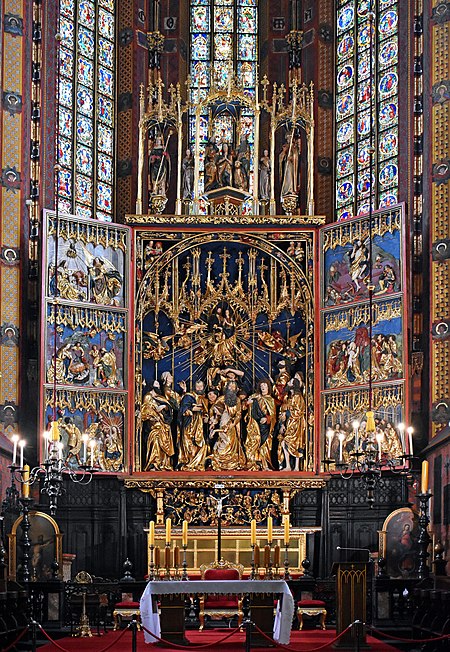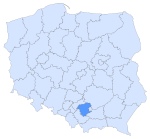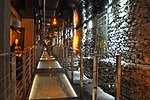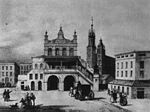Kraków Voivodeship 1300–1795 (Latin: Palatinatus Cracoviensis, Polish: Województwo Krakowskie) – a unit of administrative division and local government in the Kingdom of Poland from the 14th century to the partitions of Poland in 1772–1795 (see History of Poland during the Piast dynasty, Kingdom of Poland (1385–1569), and Polish–Lithuanian Commonwealth). Located in the southwestern corner of the country, it was part of the Little Poland province (together with two other ancient voivodeships of Poland – Sandomierz Voivodeship, and Lublin Voivodeship).
Kraków Voivodeship emerged from the Duchy of Kraków, which was created as Seniorate Province in the Testament of Bolesław III Krzywousty (1138). According to Zygmunt Gloger, it was one of the richest provinces of the Kingdom of Poland, with salt mines in Bochnia and Wieliczka, silver and lead mines in Olkusz, and very fertile soil around Proszowice. Its boundaries changed little for centuries. In 1457, the Duchy of Oświęcim was incorporated into the voivodeship, in 1564 – the Duchy of Zator (the Silesian County was created out of the two), and in 1790, the Duchy of Siewierz. Among cities and towns of contemporary Poland, which were part of Kraków Voivodeship, are Będzin, Biała, Bochnia, Brzesko, Częstochowa, Dąbrowa Górnicza, Jasło, Jaworzno, Jędrzejów, Krzepice, Kłobuck, Miechów, Nowy Sącz, Nowy Targ, Oświęcim, Sosnowiec, Szczekociny, Zakopane, Zator, Zawiercie, and Żywiec. In the first partition of Poland, in 1772 Habsburg monarchy annexed southern half of the voivodeship (south of the Vistula). In 1795, the third and final partition of Poland, Austria annexed the remaining part of the province, with the exception of its northwestern corner (around Częstochowa), which was seized by the Kingdom of Prussia, as New Silesia.
Zygmunt Gloger in his monumental book Historical Geography of the Lands of Old Poland gives a detailed description of Kraków Voivodeship:
Kraków Voivodeship covered Subcarpathian Lechia on the right bank of the Vistula, as well as land on the left bank of the river, between Kraków and Sieradz, where the Warta and the Pilica have their sources. Little is known about early history of southern areas of this province, and our knowledge is based on legends. We know that there was a prince named Krakus or Krak, after whom the city of Kraków was named (...) Local tribes, which remained pagan, were separated from the world by the Carpathians, so there are no documents about their origins (...) During the reign of Duke Mieszko I, the Bohemia state reached as far as Kraków, which was annexed by Bolesław Chrobry in 999 (...)
In 1138, following the Testament of Bolesław III Krzywousty, the Duchy of Kraków was granted to Wladyslaw, the eldest son of Krzywousty. Boundaries of the duchy were most likely the same as boundaries of Kraków Voivodeship. In 1397, three counties were created: Kraków, Proszowice and Zarnowiec. In the 16th century, there were seven counties in the voivodeship: Proszowice, Szczyrzyc, Lelów, Książ Wielki, Silesian, Biecz and Nowy Sącz (...)
Boundaries of Kraków Voivodeship were as follows: in the north it partly went along the Liswarta river, crossing the Pilica between Koniecpol and Lelów. The towns of Secemin, Sobków, Pińczów, Opatowiec, Szczurowa, Wojnicz, Tuchów, Brzostek, Kołaczyce and Jedlicze belonged to Sandomierz Voivodeship, while Lelów, Jędrzejów, Działoszyce, Skalbmierz, Koszyce, Szczepanów, Zakliczyn, Jodłowa, Jasło, Dukla and Jaśliska were part of Kraków Voivodeship. Southern border was marked by the mountains, beyond which lies Spis (...) In the west, Kraków Voivodeship included three Silesian duchies, namely Duchy of Oświęcim (since 1457), Duchy of Zator (since 1494) and Duchy of Siewierz (since 1443) (...)
In the 16th century, Kraków Voivodeship had the area of 3,451 square miles, with 466 Roman-Catholic parishes, 71 towns and cities, and 2,206 villages (...) It had seven senators: the Bishop of Kraków, the Castellan of Kraków, the Voivode of Kraków, the Castellan of Wojnicz, and Castellans of Nowy Sącz, Biecz and Oświęcim. Starostas resided in such locations, as Kraków, Sacz, Biecz, Spisz, Badzyn, Czchow, Czorsztyn, Dębowiec, Dobczyce, Grybów, Jadowniki, Jodłowa, Jasło, Krzeczow, Lanckorona, Lelów, Libiąż, Mszana Dolna, Nowy Targ, Olsztyn, Ojców, Rabsztyn, Wolbrom, and others. Local sejmik took place at Proszowice, where eight deputies were elected to the Sejm and Lesser Poland Tribunal in Lublin (...)
The Duchies of Oświęcim and Zator had their own sejmik at Zator, electing two deputies. These two Duchies had 160 villages, and six towns (Oświęcim, Zator, Żywiec, Kęty, Wadowice and Berwald). The Duchy of Siewierz, which belonged to Bishops of Kraków, had two towns (Siewierz and Sławków) (...) Kraków Voivodeship was regarded as the richest part of the Kingdom of Poland. It was the favourite province of King Kazimierz Wielki, and during the reign of the Jagiellon dynasty, a great number of palaces and castles was built here. Kraków Voivodeship had plenty of old churches, chapels, tombs, and other historical buildings (...) Among popular places there were Cistercial Abbey at Mogila near Kraków, Benedictine Abbey at Tyniec, Jasna Góra Monastery at Częstochowa, Franciscan church and abbey at Stary Sącz. Among major castles were Tenczyn Castle, Lipowiec Castle, Siewierz Castle, Smolen Castle, Bobolice Castle, Czorsztyn Castle, Olsztyn Castle, Ojców Castle, Pieskowa Skała Castle, Wojnicz Castle, Stará Ľubovňa Castle and others.
Voivodeship Governor (Wojewoda) seat:
KrakówSejmiks (or territorial) seat:
ProszowiceRegional council (sejmik generalny) seat:
Nowe Miasto Korczyn











